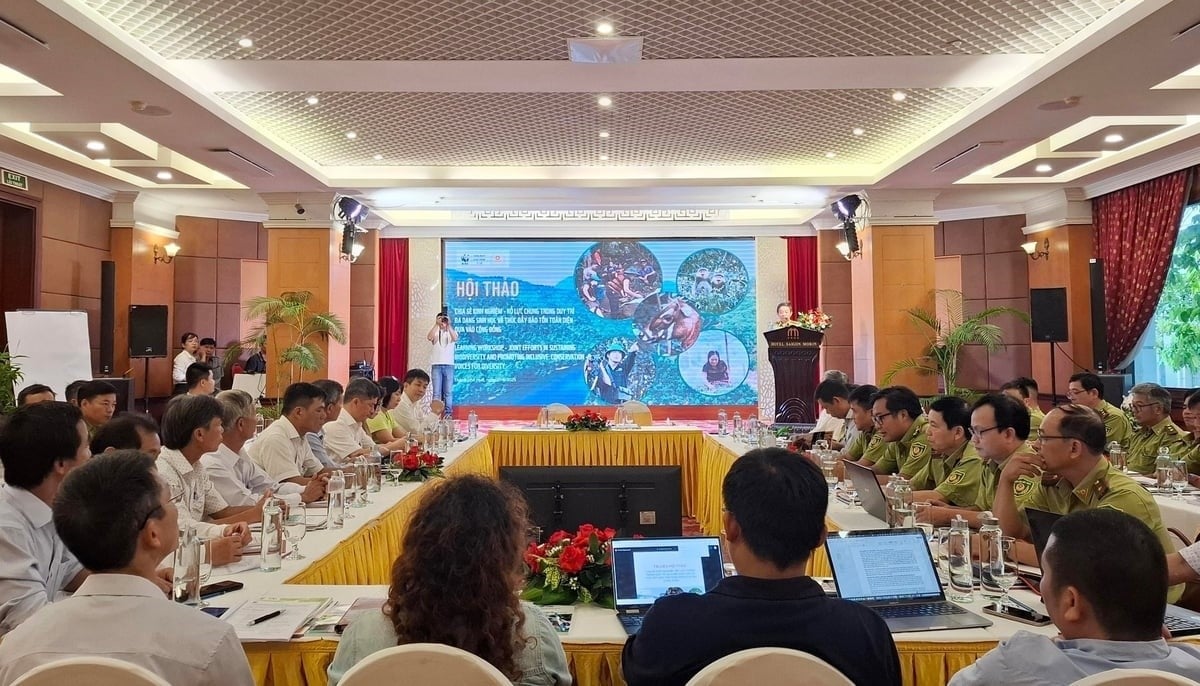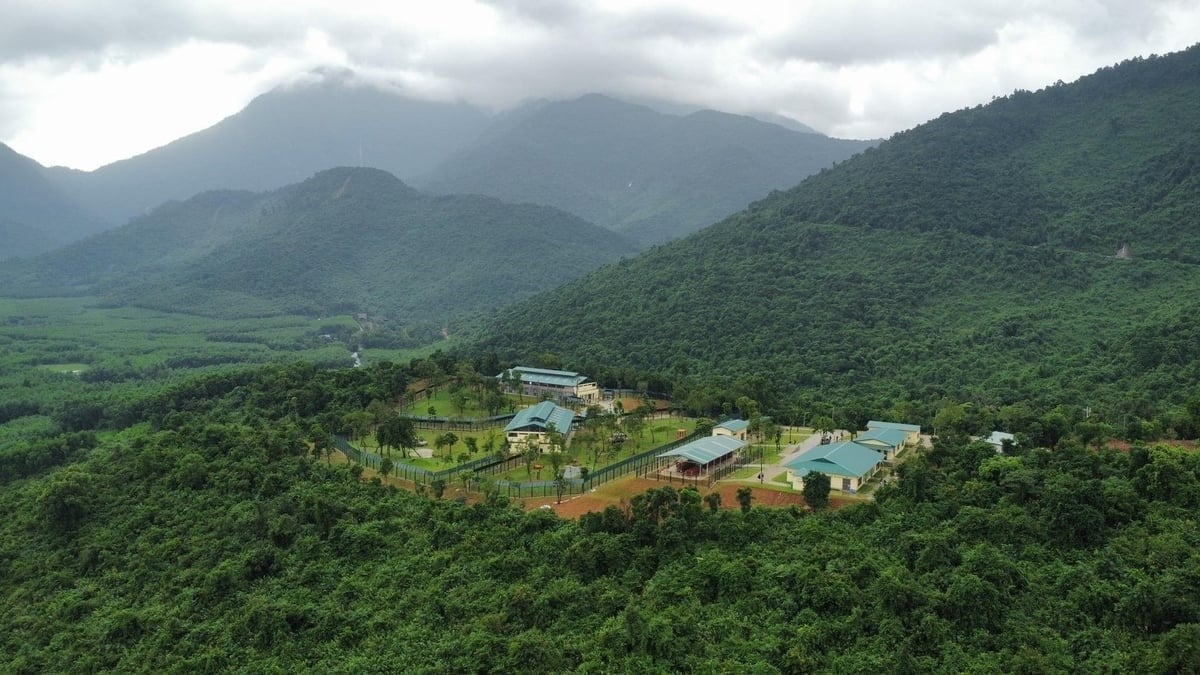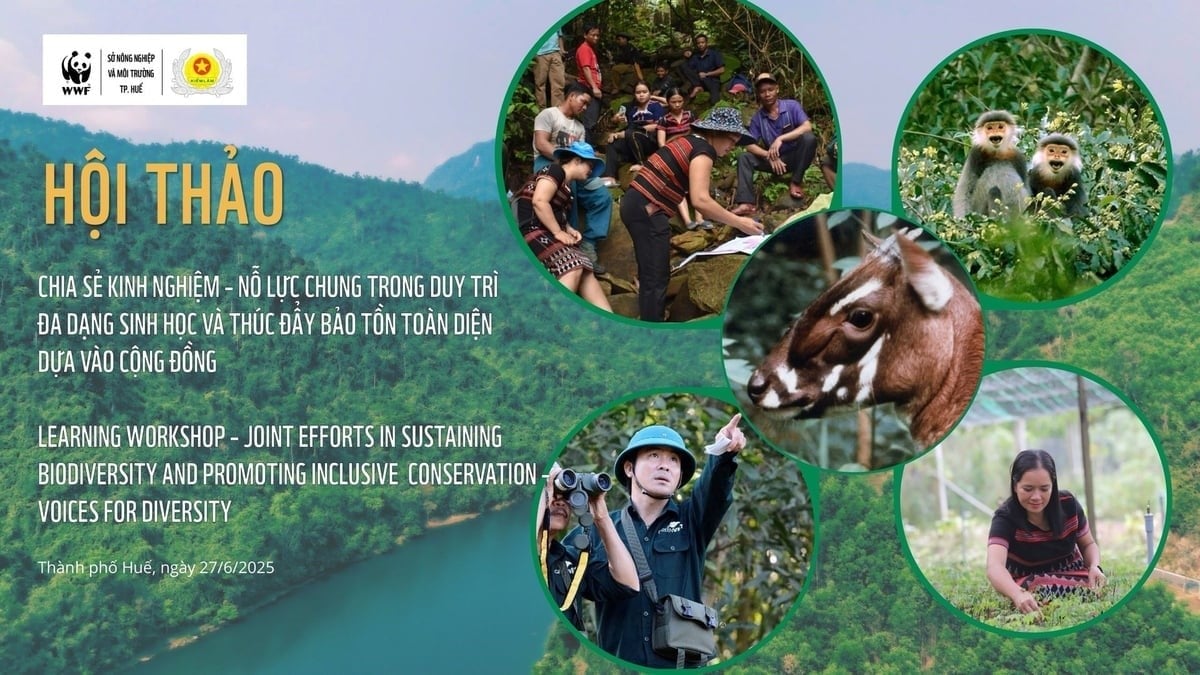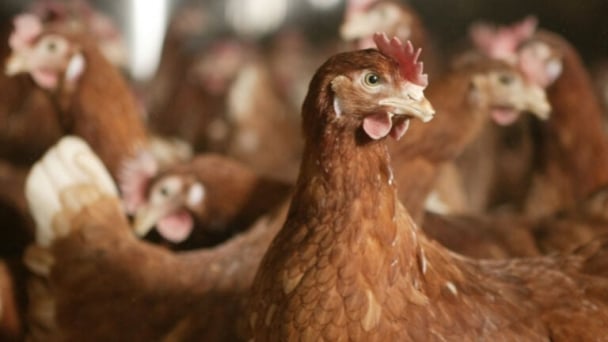June 28, 2025 | 11:28 GMT +7
June 28, 2025 | 11:28 GMT +7
Hotline: 0913.378.918
June 28, 2025 | 11:28 GMT +7
Hotline: 0913.378.918
On the afternoon of June 27, in Hue City, WWF-Vietnam coordinated with the Department of Agriculture and Environment of Hue City to organize a workshop titled “Learning Workshop – Joint Efforts in Sustaining Biodiversity and Promoting Inclusive Conservation Voices for Diversity.” The event was part of the “Raising Our Voices to Protect the Saola and Ecosystems for Nature and People” project (referred to as the Project), funded by the Swedish International Development Cooperation Agency (Sida) and jointly implemented by the Hue City Forest Protection Sub-Department and WWF-Vietnam.

Workshop titled “Learning Workshop – Joint Efforts in Sustaining Biodiversity and Promoting Inclusive Conservation Voices for Diversity.” Photo: Van Dinh.
Speaking at the workshop, Mr. Hoang Xuan Huy, Director of External Affairs at WWF-Vietnam, stated that the Project has delivered concrete and practical outcomes. Notably, the capacity and engagement of social organizations and local communities have been significantly strengthened; many community forest protection regulations have been reviewed and updated in accordance with the Law on Forestry 2017. Patrols to protect the Saola and other rare and endangered wildlife species in the Saola Nature Reserve have been regularly maintained, with strong participation from local forest rangers.
In particular, pioneering initiatives such as the “Community to Community” initiative, the Grey-shanked Douc Langur Protection Group model, and knowledge-sharing activities for local students have demonstrated that conservation can go hand in hand with education, livelihoods, and intergenerational connection.
“We hope that today's workshop will provide a platform for more stories, lessons, and initiatives from those directly involved in forest and wildlife protection. These insights will help us collectively enhance, scale up, and sustain the Project's results in the coming time,” said Mr. Huy.
At the workshop, WWF-Vietnam officially announced the Central Annamites Landscape Strategy for the 2025–2030 period, which sets a comprehensive direction for forest conservation, ecosystem restoration, and sustainable livelihood development in one of the most biologically diverse regions in Vietnam and Southeast Asia.

At the workshop, WWF-Vietnam officially announced the Central Annamites Landscape Strategy for the 2025–2030 period. Photo: Van Dinh.
The Central Annamites Landscape Strategy for the 2025–2030 period sets goals of protecting and restoring forest ecosystems, maintaining habitat connectivity, and promoting sustainable livelihoods. The strategy focuses on six key priorities, including connecting biodiversity corridors; improving habitat quality; promoting sustainable forest management; reducing greenhouse gas emissions; promoting the assessment and reporting of areas with other effective conservation measures (OECMs) beyond protected areas; and integrating sustainable financing, private sector engagement, and social inclusion.
This strategic orientation not only supports the conservation work but also contributes to green economic development, climate change adaptation, and the fulfillment of Vietnam’s international commitments, such as the National Biodiversity Strategy and Action Plan (NBSAP) and the Global Biodiversity Framework (GBF).
“The Central Annamites is a landscape of global conservation significance. However, habitat fragmentation has affected the survival of native species in this region. As a result, the development and implementation of the Central Annamites Landscape Conservation Strategy has been given special attention by the Hue city government and WWF. This strategy aligns with the city’s vision to become an environmentally friendly city, with beautiful natural landscapes, climate resilience, and sustainable development,” said Mr. Nguyen Dai Anh Tuan, Deputy Director of the Department of Agriculture and Environment of Hue City.
Recognizing the importance of habitat connectivity and conservation, the Project has reviewed the forest and forest land status at the Bac Hai Van Protection Forest Management Board (Hue city) in April 2025. This activity aimed to evaluate the current situation of forest resource management and biodiversity values, serving as the scientific and practical basis for the establishment of the Bac Hai Van Landscape Protection Area.
This area holds a strategic position within the Central Annamites ecological corridor, connecting the Saola Nature Reserve, Bach Ma National Park, and coastal ecosystems. It is considered the first step for a sustainable resource management model with the participation of local communities.

The “Raising Our Voices to Protect the Saola and Ecosystems for Nature and People” project has delivered many concrete and meaningful outcomes. Photo: Organizing Committee.
Mr. Nguyen Hoai Khuong, Project Manager at WWF-Vietnam, said, “Bac Hai Van plays a special role in maintaining the ecological connectivity of the entire Central Annamites. Effectively protecting this area means safeguarding the overall biological structure of the landscape while supporting the implementation of the National Biodiversity Strategy and promoting nature-based solutions at the local level.”
Recognizing the vital role of communities in forest protection, the Project collaborated with local governments and communities in Hong Kim, Hong Van, and Quang Nham communes (A Luoi district, Hue city) to update five Community Forest Management Agreements. These revised agreements clearly define the rights, responsibilities, and coordination mechanisms among local people, government, forest rangers, and other stakeholders in protecting assigned forest areas.
The content of the agreements closely reflects local realities, aligns with livelihood conditions and indigenous cultural practices, and complies with new legal frameworks on forestry and biodiversity. The success of this activity has contributed to raising awareness and strengthening the responsibility and voice of local communities in forest resource management, laying the foundation for community-based co-management models and promoting the implementation of conservation commitments at the grassroots level.
The workshop is also an opportunity for delegates to share typical community-based conservation initiatives and models, such as the Pioneering Grey-shanked Douc Langur Protection Group in Tam My Tay (Quang Nam), the Community Conservation Group in Tuyen Hoa district (Quang Binh), and the Saola Protection Patrol Team (Hue). In addition, activities such as updating community forest management regulations and policy advocacy initiated by social organizations were introduced, reflecting grassroots creativity and commitment.
Translated by Thu Huyen
![Lifting the IUU 'yellow card': [2] Thorough preparation for the EC inspection](https://t.ex-cdn.com/nongnghiepmoitruong.vn/608w/files/huytd/2025/06/27/3109-1-005033_548.jpg)
(VAN) Ahead of the fifth inspection by the EC, Khanh Hoa and Phu Yen have controlled fishing vessels, catch volumes at ports, and VMS equipment to meet the requirements for lifting the IUU 'yellow card.'

(VAN) Since the implementation of Resolution No. 03 by the People's Council of Tuyen Quang province, 282 organizations and individuals have been supported with advanced, water-saving irrigation systems, covering a total area of 765 hectares.
![Lifting the IUU 'yellow card': [1] Fisherpeople join forces](https://t.ex-cdn.com/nongnghiepmoitruong.vn/608w/files/huyenvt (e)/2025/06/26/0551-4-205700_585.jpg)
(VAN) To lift the EC's 'yellow card,' fisherpeople have significantly raised their awareness in complying with legal regulations in marine fishing activities.

(VAN) Research has shown that Hy-Line brown hens may be better suited for cage-free production based on overall greater egg production and other quality metrics.
![Turning wind and rain into action: [9] Digitizing hydrometeorological data in response to climate change](https://t.ex-cdn.com/nongnghiepmoitruong.vn/608w/files/news/2025/06/17/z6704423696987_15fd32ffc26d590d204d520c9dac6786-nongnghiep-165943.jpg)
(VAN) Farmers have begun accessing hydrometeorological applications to adjust their cropping schedules, aiming to ensure productivity and adapt to climate change.
![Turning wind and rain into action: [8] Real-time salinity detection and early warning technology](https://t.ex-cdn.com/nongnghiepmoitruong.vn/608w/files/news/2025/06/17/z6704423696987_15fd32ffc26d590d204d520c9dac6786-nongnghiep-151127.jpg)
(VAN) Thanks to the integration of modern hydrological-hydraulic models, remote sensing technologies, and artificial intelligence, the accuracy of hydrological forecasting has significantly improved.